There’s no fancy way of saying this, so I’ll just say it:
Pop-ups aren’t dead. Some people think they are, but they’re not.
Ask yourself this for a moment — why do you think pop-ups are dead? I bet the tune in your head sounds something like this:
“I think they’re annoying, and people say they’re annoying. Hence, annoying.”
Annoying. Got it.
But are they really? Marketers know the thoughts people have vs. the actions they take are two totally different things. Social psychologist Martin Lindstrom found as much and even published a book about it.
So it’s not that pop-ups don’t work. Sumo users collected 23,645,948 email addresses with List Builder pop-ups in less than two years. Email addresses they can now use to grow their businesses.
Pop-ups work. There’s just a misunderstanding about what makes a successful pop-up (that isn’t annoying).
To show you how big of a misunderstanding there is, I’ll ask you this question: which pop-up do you think was more successful?
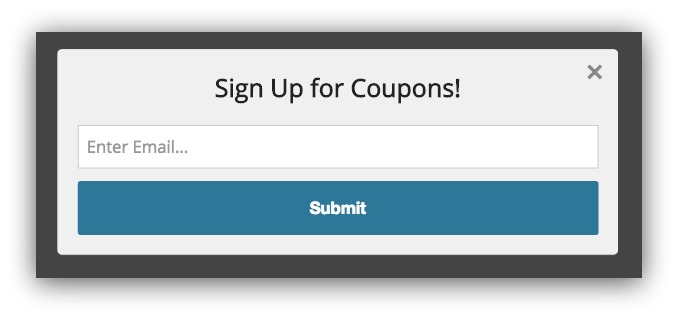
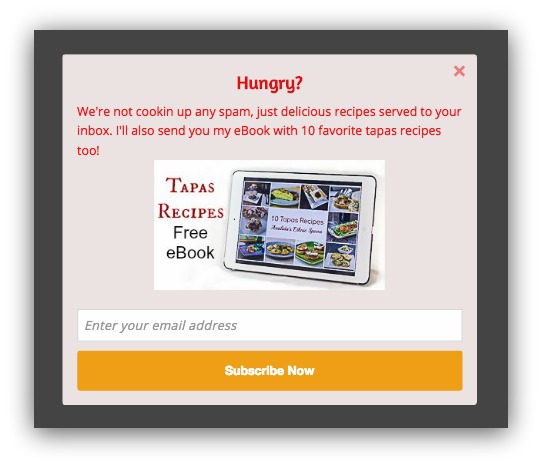
Guess what?
The first pop-up performs over 30% better!
You might think the bottom one should’ve won. It follows all the common pop-up best practices. It has:
- An image that serves as a CTA
- A provoking headline
- Bright colors
- A great giveaway.
The first pop-up has four words and a button that says “Submit.”
But the results come down to how each site utilized their pop-up. There are so many factors that go into creating a successful pop-up that even one misstep can tank your conversion rate.
So here I am, ready to show you how pop-ups really work. Because, after analyzing data from almost two billion pop-ups, we’ve found some surprising statistics that will change the way you look at pop-ups.
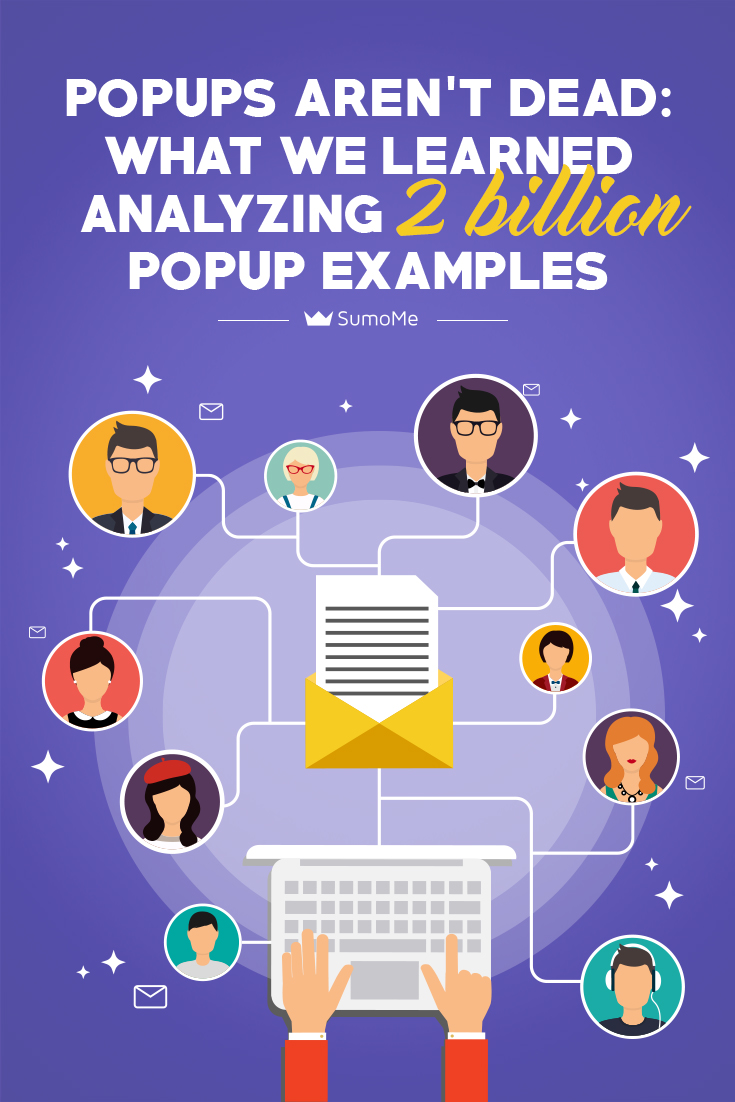
The Stats Behind Pop-ups (And What You Can Expect)
Not all pop-ups are created equal. But there are some reasonable expectations you can have going in (if you follow the advice in this guide).
When we took a look at the 1,754,957,675 pop-ups in this study, we found a few choice nuggets about pop-up conversion rates (click to share them on social media):
-
The top 10% highest-performing pop-ups averaged a 9.28% conversion rate. And, by conversion rate, we mean someone who saw a pop-up and took action.
-
Only 3 out of 100 people ever have pop-ups with conversion rates over 11%.
-
The average conversion rate for all pop-ups is 3.09%.

Share this Image On Your Site
The Top Pop-ups Average a 9.28% Conversion Rate
Some pop-ups see conversion rates as high as 50.2%! But the average conversion rate of the very best pop-ups was 9.28%.
To put that into perspective, if you get even 150 visitors per day to your site you’d have 418 signups in a month.
That kind of conversion rate would put you in the top 10% of pop-up creators.
The Average Pop-up Conversion Rate Is 3.09%
Most pop-ups fall into this category. The average represents not only a benchmark but also a tale of what large traffic can do to a conversion rate.
The more pop-up impressions you get from more traffic, the lower your conversion rate will (usually) be. So while 3.09% might seem small, imagine you have 100,000 visitors on your site.
That turns into over 3,000 subscribers.
That makes the 3.09% average seem alright in retrospect.
But how do you reach that average? And how do you turn a pop-up into 50% conversion machine?
Let me show you what science says.
The Findings: 8 Elements That Make (Or Break) Pop-ups
I tried to make this in college:
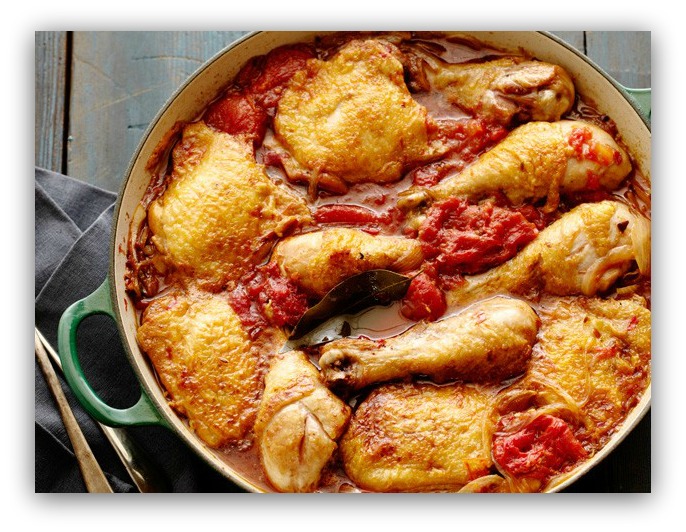
I had a date. I had to impress this girl. My ego was on the line.
She took one taste of that dish and dropped her fork. Not in the good way, either.
So there I am, a devastated 19 year-old, blankly staring at her across the table and wracking my mind as to where I went wrong.
Turns out I didn’t cook it for long enough. Whatever. I tried to pass it off as a French thing, but she wasn’t having any of that. Date. Over.
Thankfully I’m a better marketer than a cook. And the pop-up lesson we learn from my horrible date is this: one small mistake can ruin an otherwise excellent composition.
Many of those 1.75 billion pop-ups had a lot going for them. But there would be one or two small things that would cripple their conversion rates.
After analyzing all those pop-ups, I found eight bulletproof elements that increase or decrease your pop-up conversion rates. And I’ll use examples from the highest-performing pop-ups in existence so you can see exactly what to do.
- Pop-ups With More Context Have Higher Conversion Rates
- The Highest-Converting Pop-ups Don’t Appear Immediately
- Being Unclear With Your Headline And Offer Will Sink Your Conversion Rates
- Personality Creates Interest
- The Best Pop-ups Offer Something of Value
- Pop-ups Shouldn’t Appear Immediately After A Visitor Closes Out
- Calls To Action Need To Match The Offer
- Exit Pop-ups Need An Overwhelmingly Valuable Offer
1) Pop-ups With More Context Have Higher Conversion Rates
Gary V says it best: Content is king. Context is God.
You might have the best content in the world. But if the context is wrong, then the message dies.
Context is what you surround your message with. Context gives additional meaning and understanding to your message.
Oh, and context is what gives the best pop-ups conversion rates over 40%.
At the tippity top of the highest converting pop-ups stands a very firm trend — context. Your web page does the work of establishing value, then the pop-up materializes out of nowhere, building on that value.
But that’s no coincidence. You control where the pop-up appears, after all. Take this high-converting pop-up for example:
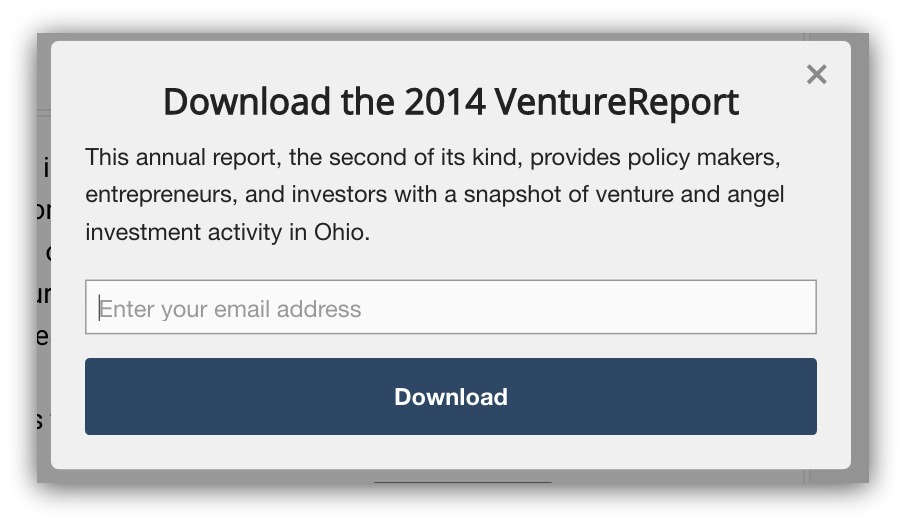
This would be a strange giveaway on a home page. You wouldn’t want to offer an annual report to every visitor on your site.
That’s why this pop-up doesn’t do that. It appears on a special page that gives a high-level look at the company’s annual numbers and performance.
That’s why this pop-up is successful. It’s the context — the information on the page that feeds the pop-up.
Here’s a bit of context in action. We wrote a 6,500 word guide on the scientific online marketing strategy behind exponential growth:
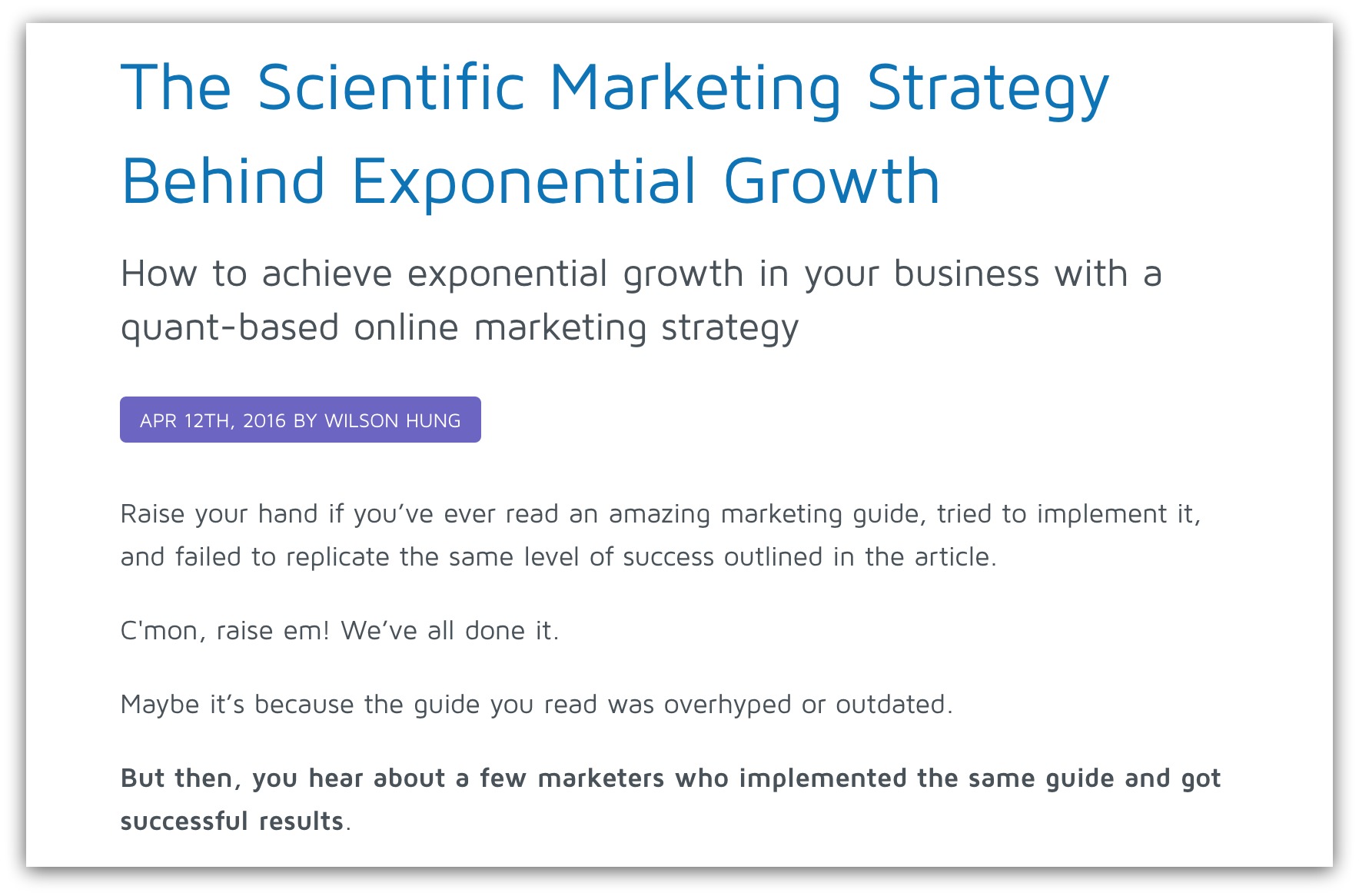
After reading a bit into that guide, you’d see this popup:
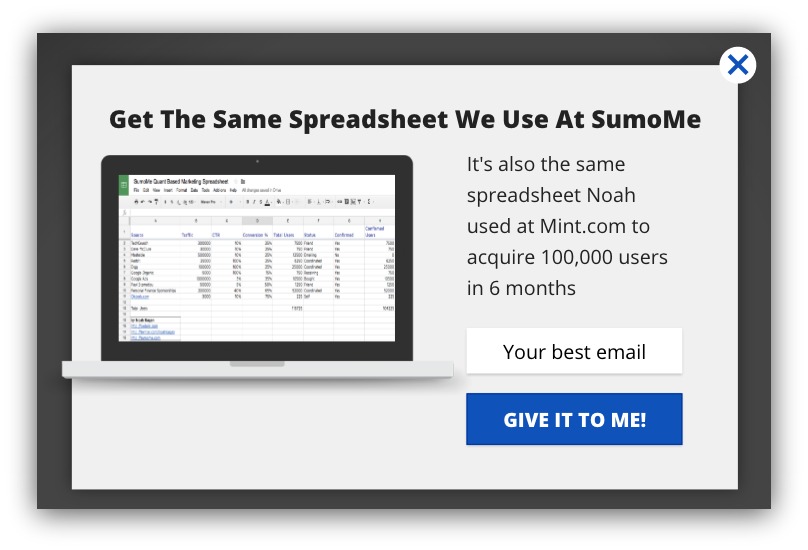
If you read through the guide, you’d know this spreadsheet is key for your marketing strategy. If you saw this pop-up on any other page, however, you’d wonder what that spreadsheet is and why you need it.
Nail context on a pop-up by imagining the process as a conversation. I do that for every pop-up I create, and it makes the interaction seem a lot more natural.
For example, if you thought about context in a conversation, you might get this:

It’s harder to sell someone chairs without knowing what they came in the store for. But if you knew they were buying a table, your chances increase.
Same goes for pop-ups. If you’re asking someone to interact with an ordinary pop-up on the homepage, your conversion rate will be low.
But if you ask for something in context, you’ll have better results. Here’s a few examples of pop-ups with context you can try on your own site:
- Newsletter Signup On Blog Post: Why ask for someone to get blog updates before they’ve read a blog post? Ask them as they read an article. The context of a good article will strengthen your ask.
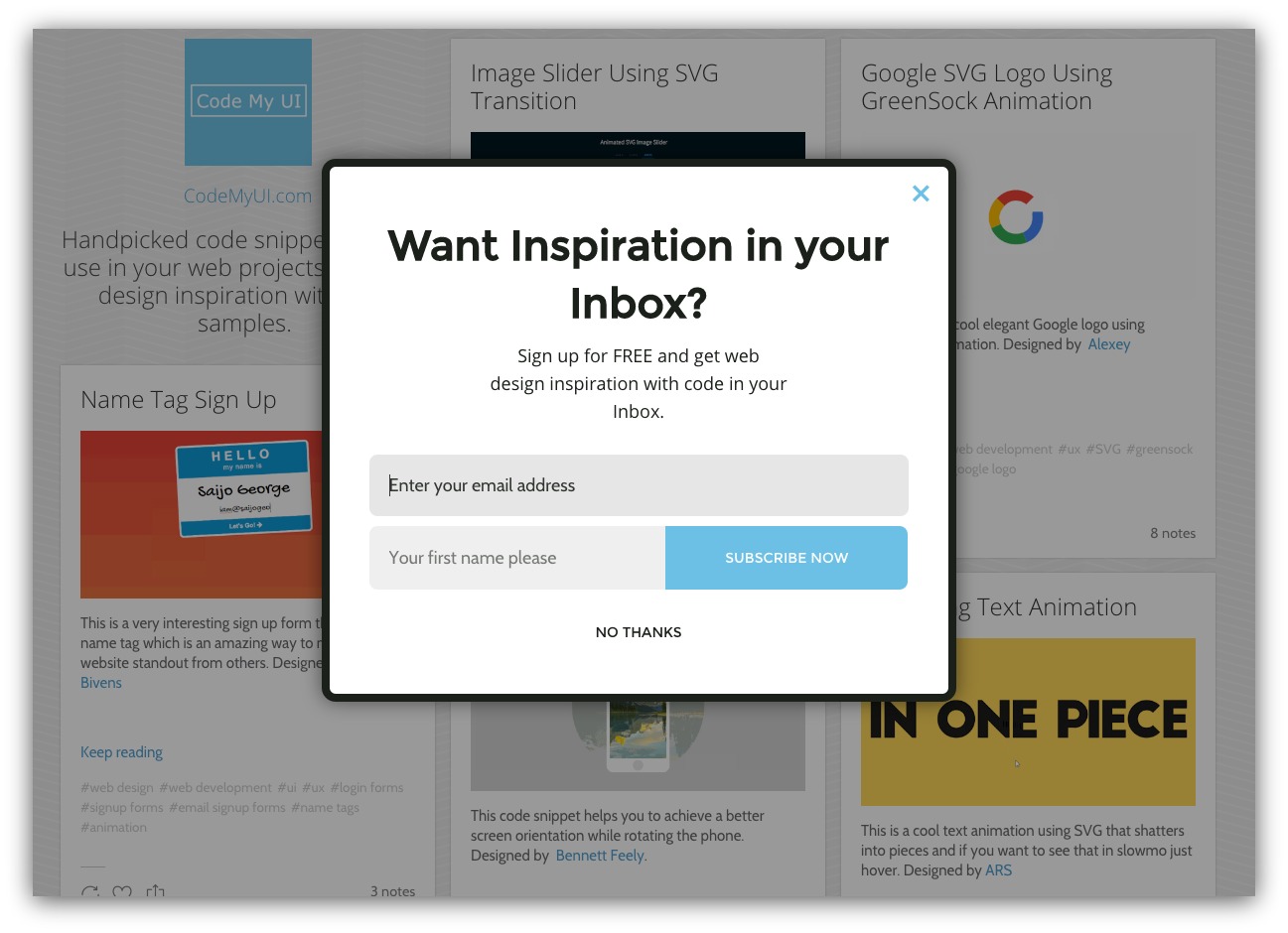
- Content Upgrade On Specialized Page: Got a page about marketing automation? That’s the perfect time for a pop-up to offer an email course on marketing automation. Build on the topic of your page with a content upgrade.
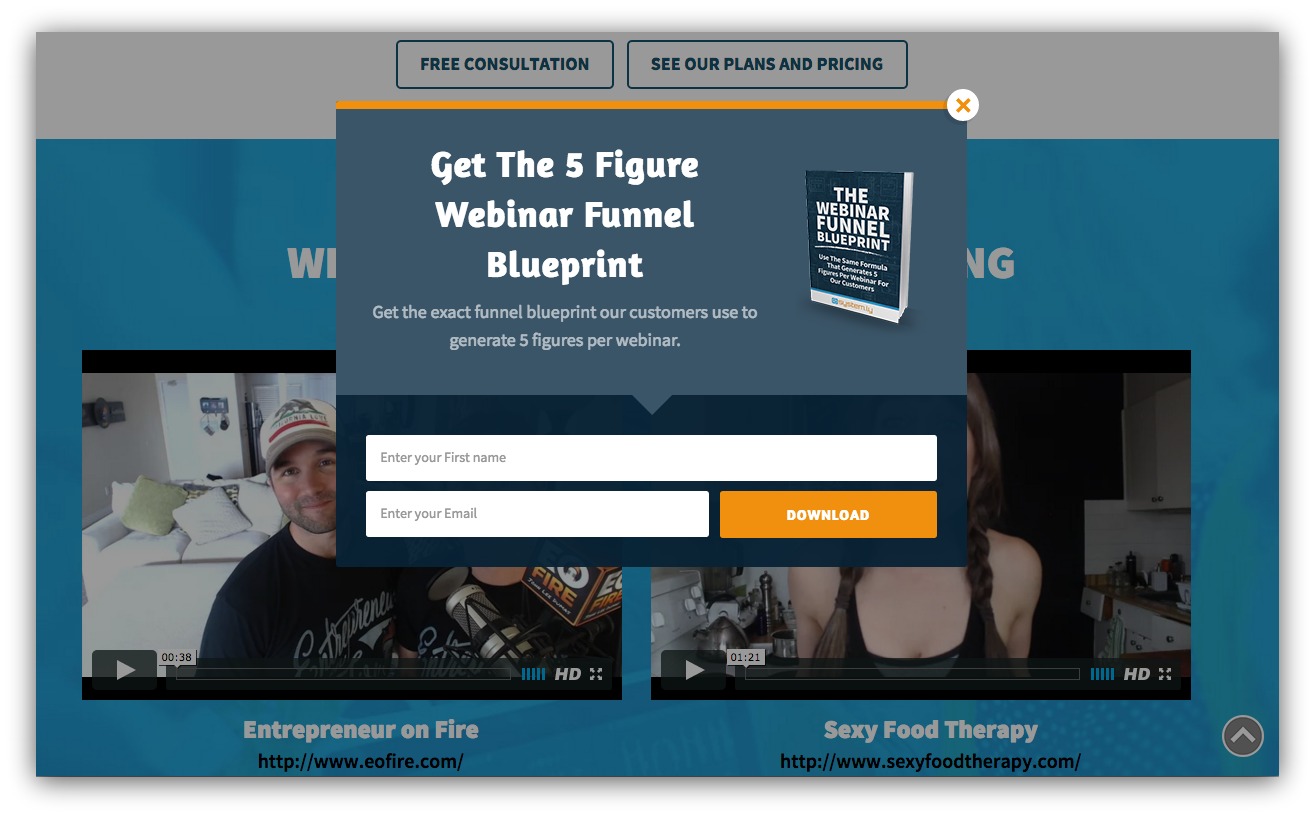
- Discount On Product Page: They may be on the fence about buying something, but when a pop-up hits them with a 10% discount? Game over. Drill down to the pages where your customers buy and present them with an offer that’s hard to refuse.
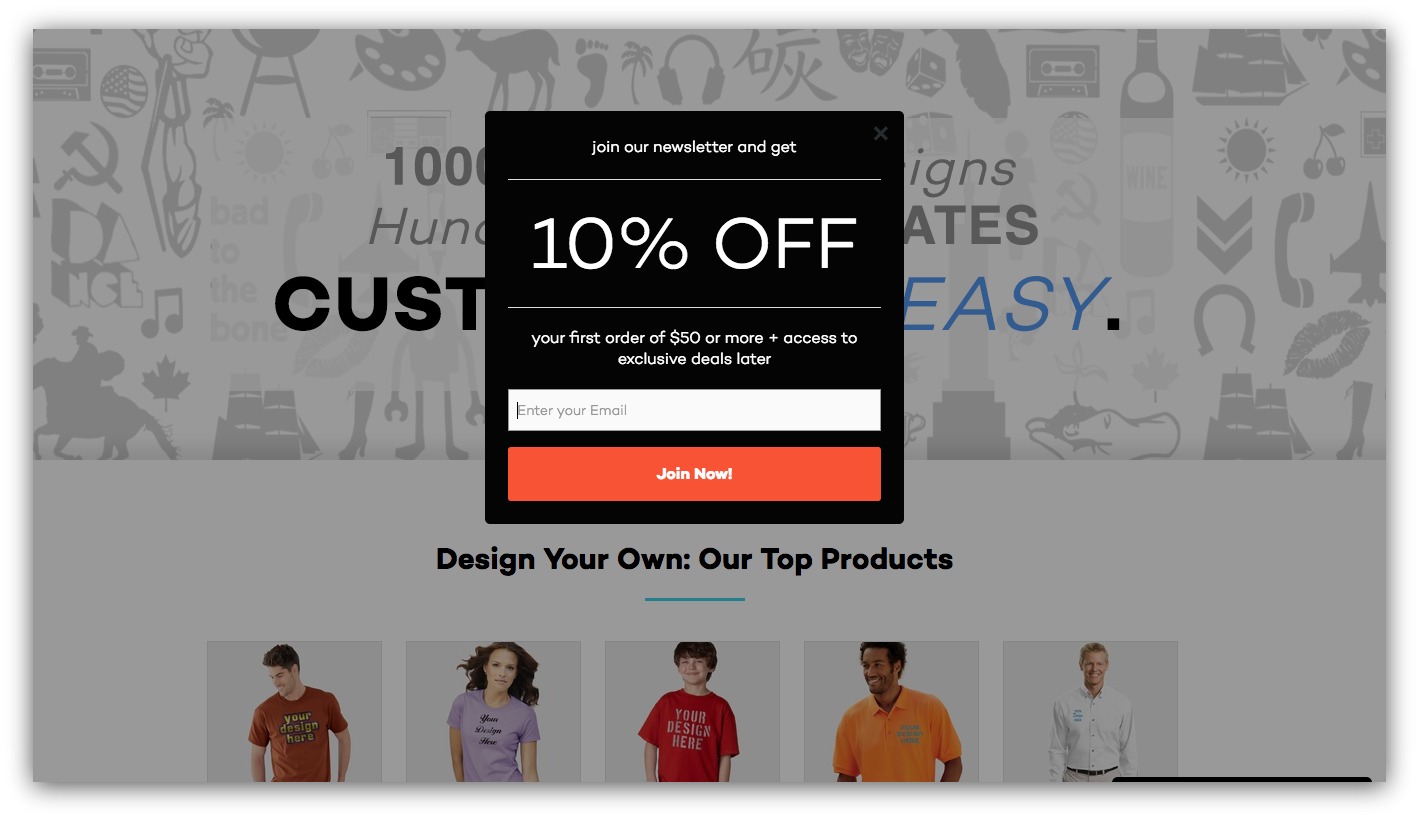
Context shapes your pop-up. Above all, don’t forget this tip.
2) The Highest-Converting Pop-ups Don’t Appear Immediately
Let’s think about this like a conversation again:

Have you ever had a salesperson greet you at the door, already harassing you to buy whatever they’re peddling that day?
You haven’t even looked around in the store yet. You don’t even know if you need something. You might just be browsing. So what are the chances you buy what Joe Salesperson is selling?
Probably small. But what if they approached you after you’ve had time to browse? Better yet, what if they approached you during a decision-making process?
That’s much more effective.
That’s why the best pop-ups give visitors time to see the site and get invested. How many times have you seen a pop-up like this?

Did you get a chance to even read the headline? Nope, and that’s a shame because there’s a good Matthew McConaughey reference there.
If they haven’t read two words on your site then how can you expect them to subscribe/buy/do anything for you?
Of the top 10% of pop-ups, only 8% had pop-ups appear in the 0-4 second mark. And the majority of those 8% were on pages where the pop-up was expected to appear quickly — as in sending someone to a download page.
On the flip side, guess what the lowest-converting pages had in common? Rushed pop-ups.
So how long is long enough? It depends on your page.
Timing and context are the two elements that go hand-in-hand here. You need to know where someone is in their journey in order to know when to show the pop-up.
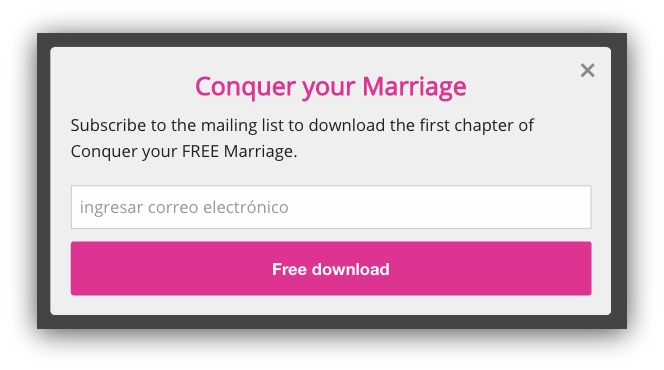
Here’s a pop-up that appeared 15 seconds after a visitor viewed an ebook product page. The pop-up offers the first chapter of that book for free, and it converts at a whopping 38.4%.
They knew people would be interested in the book, and they guessed 15 seconds was long enough for a reader to seriously consider purchasing the book.
There’s no silver bullet for a best-practice time. But there are two things you can do to find your specific best time:
-
Google Analytics Time on Page: Remember, you should be showing your pop-up on a specific page. Once you know that page, go into Google Analytics and see the average time on page. That’ll get you into the ballpark of when to show your pop-up.
-
User Test: Open up your page in front of a complete stranger and see how long they’re on the page. The best part is you can ask why they left, giving you more information about your page. You can also A/B test within List Builder, setting the two pop-ups to appear at different times.
You can easily change the timing of your pop-up like so:

“Smart” turns your pop-up into an exit pop-up (more on that later). “Manual” gives you the ability to control how long it takes for the pop-up to appear.
Know where to pop-up. Know when to pop-up. Moving on…
3) Being Unclear With Your Headline And Offer Will Sink Your Conversion Rates
Hey, if one embarrassing dating story wasn’t enough, then here’s another cringe moment to help prove a point.
Oh wait. I forgot. The date never even happened.
Why? Because I never clearly said I wanted to go on a date with this girl.
Yep. Just did the whole “Yeah, totally, we should totally hang out sometime.”
Met with a, “Oh, for sure. Yeah, hanging out would be great.”
End scene. Nothing ever happened. Sean, you idiot.
I wasn’t clear. I wasn’t specific. I didn’t say exactly what I thought.
Kind of like this:
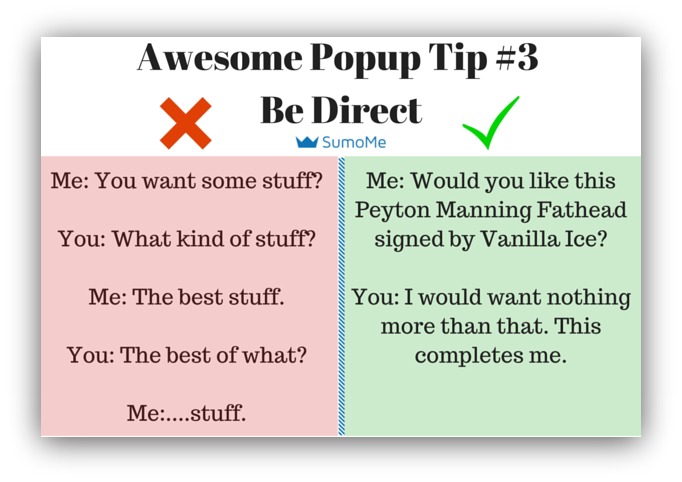
If you want your pop-up to work, you need to be clear and direct.
And asking someone to “Sign up for a newsletter to get all the best tips and updates” just won’t cut it.
Let’s break down some high-converting pop-ups to drive that point home:
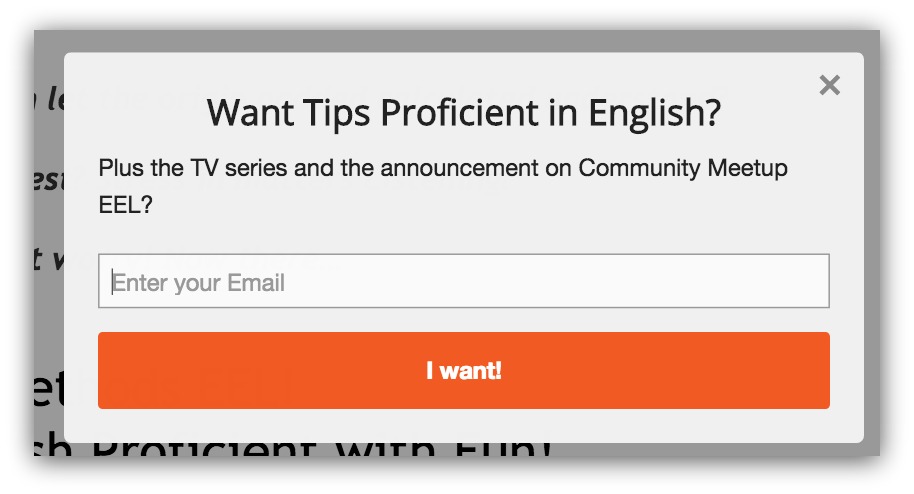
Granted, this one was translated with the Google Chrome extension, but the real headline says, “Want Some English Proficiency Tips?.”
This is on a site that teaches ESL adults English. A clear headline like that is guaranteed to capture interest.
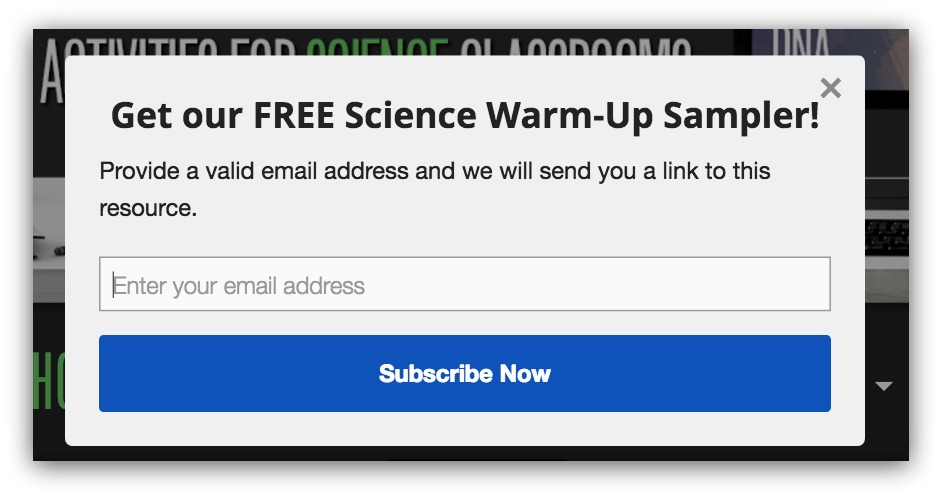
Here’s another headline that delivers a clear message. The pop-up is on an article that talks about science warm-up experiments. The headline promises a free sampler on the topic.
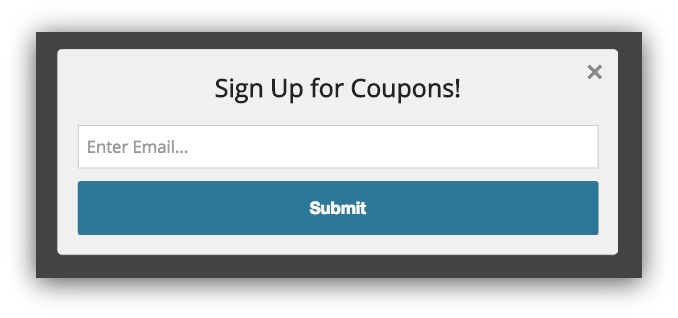
Then there’s this. It might possibly be the most direct four word phrase I’ve seen in a headline. The pop-up appears on a page full of products. So of course you’d want coupons for those products.
But sometimes the headline isn’t enough (except that last example). You also need to be direct in the description:
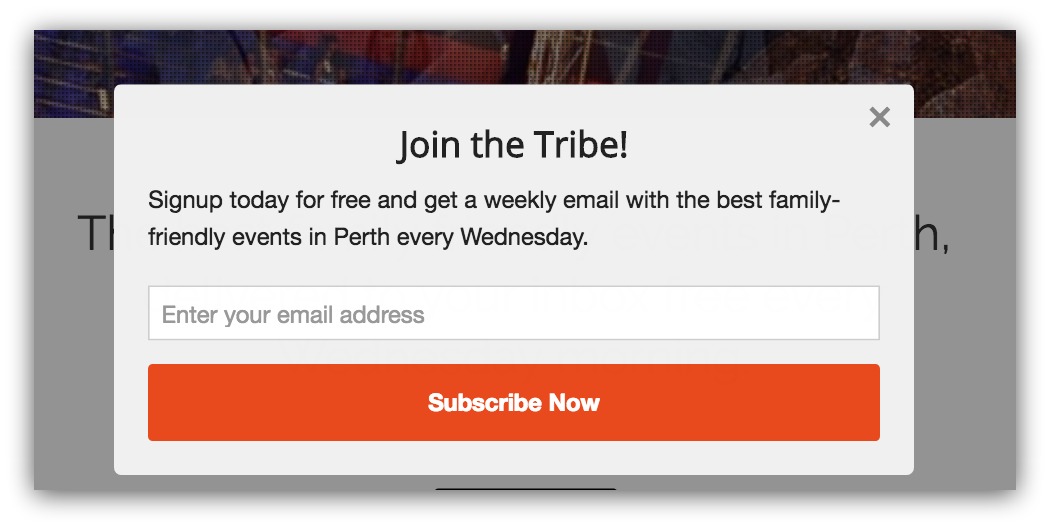
This is on an events page. The headline may be a bit fuzzy, but holy description, Batman. You know exactly what you’re getting if you sign up:
- Signup Today: Specific ask.
- For Free: Value.
- Weekly Email…Every Wednesday: You know you won’t get flooded with emails.
- Best Family Friendly Events: Specific niche.
- In Perth: Location.
That’s everything you could ask for in a clear, direct description. I guarantee no one is signing up for that newsletter accidentally.
When you’re clear and direct, you give visitors a reason to act. They don’t have to guess. They just have to decide.
4) Personality Creates Interest
I reviewed so many pop-ups for this piece.
So. Many. This was literally me after reviewing them all:

When you review that many pop-ups, they all start to blend together. Good ones, not-so-good ones and everything in between. Click, review, move on.
But some made me stop and read a little longer. Those were the ones with some personality.
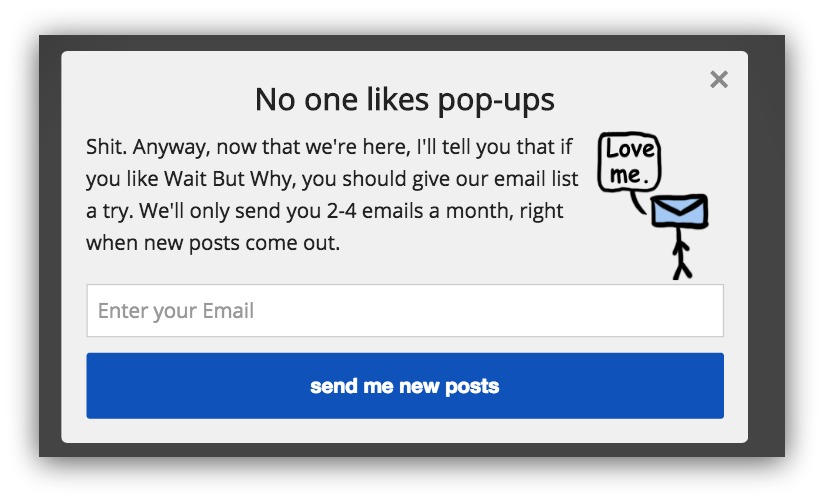
Here’s an interesting example from the mega-popular blog (and Sumo user!) Wait But Why. They connect to readers with the obvious sentiment of “no one likes pop-ups.” That’s the attention-grabber.
Then they transition into a unique ask for a blog subscription. It’s the language (nonchalantly moving on from the headline) and little touches like the stick figure that make this pop-up unique.

You see it in The Masterpiece Mom’s pop-up, too. Her’s is a friendly, personal brand, and the inclusion of “Hi there” in the title highlights that.
Plus, she ends the pop-up with “Let’s be inbox friends, shall we?” She can tack on some flair like that because her preceding sentence is direct and clear enough.
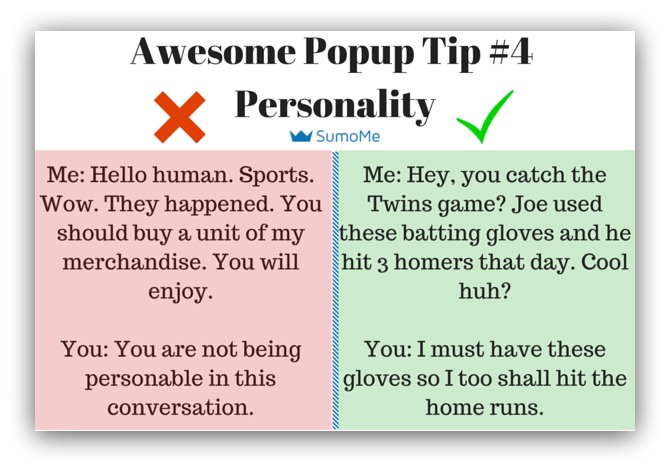
It’s tough. I get it. You only have a certain amount of words to work with, and you need to toe the line between direct and personable.
But as you’ve seen, it can be done.
Personality is, in essence, your brand. Wait But Why can be offbeat and swear. The Masterpiece Mom is warm and inviting.
Find your brand’s tone and inject it into your pop-up.
5) The Best Pop-ups Offer Something of Value
“Pop-ups aren’t valuable,” my coworker said between sips of whatever grey protein concoction-of-the-month he brought to work.
Then I pointed to the 37% conversion rate my pop-up had and did the dance from Walk Like An Egyptian.
The strange thing is, at that moment, we were both right. pop-ups, by themselves, aren’t valuable.

It’s up to you to provide value — your pop-up either builds upon it or brings it to light. You do that two ways:
-
Contextual Value: Your pop-up draws upon the value of your page. This happens most often with articles. The article is helpful, unique content, and people feel compelled to get more of that info. The pop-up then asks the reader to signup for more info.
-
Inherent Value: This is value you’ve created that only the pop-up can convey. That value comes from mostly content upgrades — videos, spreadsheets, infographics, or any other piece of content that the visitor can’t normally access. Once a visitor gives their email address, they get the content upgrade.
You see enough of the contextual examples everywhere, so let’s focus on the inherent value real quick.
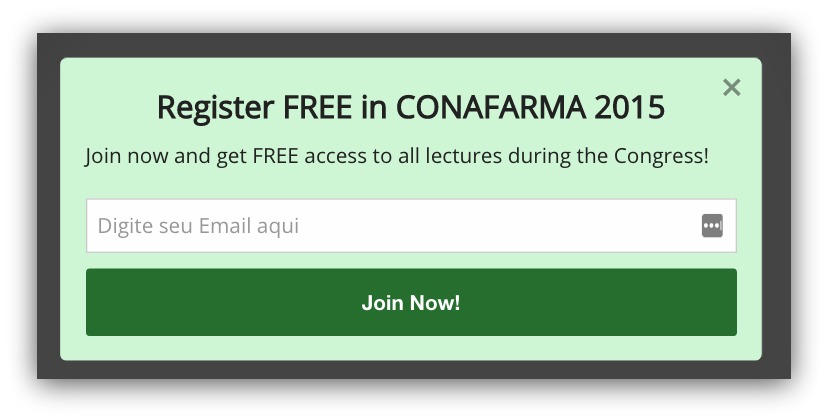
Another translated pop-up, so pardon the syntax. Still, I think you get the gist of the offer, because it’s a really good one.
If you sign up, you get free access to every lecture during their event. Assumedly, people have to pay to get into the conference. If that’s the case, this pop-up provides an insane level of value.
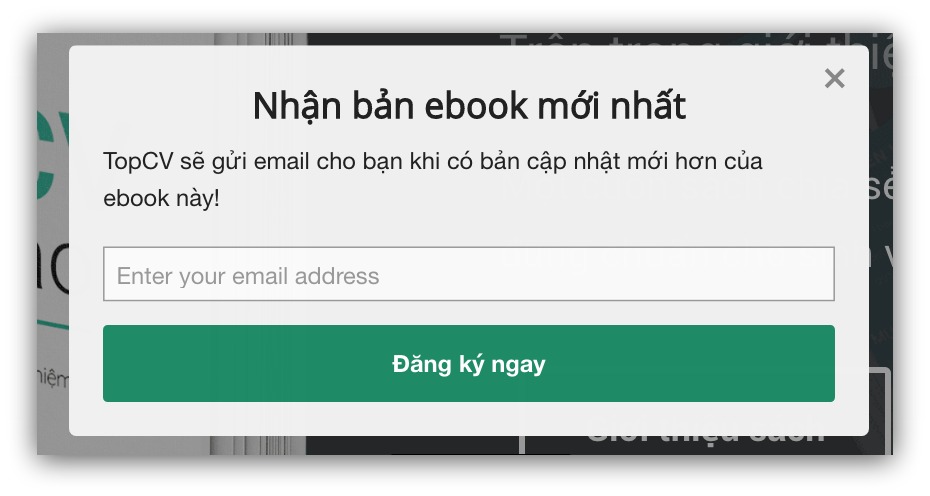
And this one…it doesn’t even need translation. It’s pretty clear.
Ok, ok. It’s in Vietnamese and the offer is for a massive ebook along with a resume template. That’s a phenomenal combination of value.
Both these were examples of inherent value. The value is inherently built in to the pop-up, as opposed to the value being in the context.
But both instances are built upon value. It’s that value that separates good pop-ups from bad ones.
6) Pop-ups Shouldn’t Appear Immediately After A Visitor Closes Out
I pray you have the patience of 700 Buddhas if you look for car insurance in this modern age.
You’re emailed almost hourly, you get calls every few days and God help you if you actually take one of those calls. You’ll run into something I call the “No Hydra.” For every no you say, you’ll have to say three more no’s.
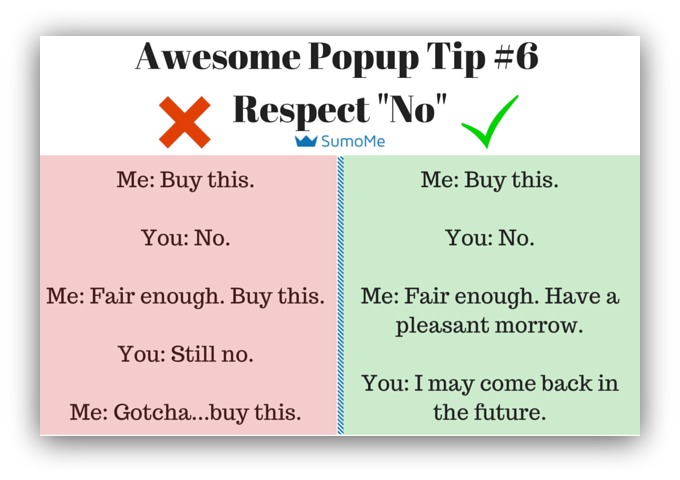
There’s nothing more annoying than having to say no over and over. It’s annoying and you feel like you’re being badgered into complying.
Your pop-ups shouldn’t do that.
How annoying is this?
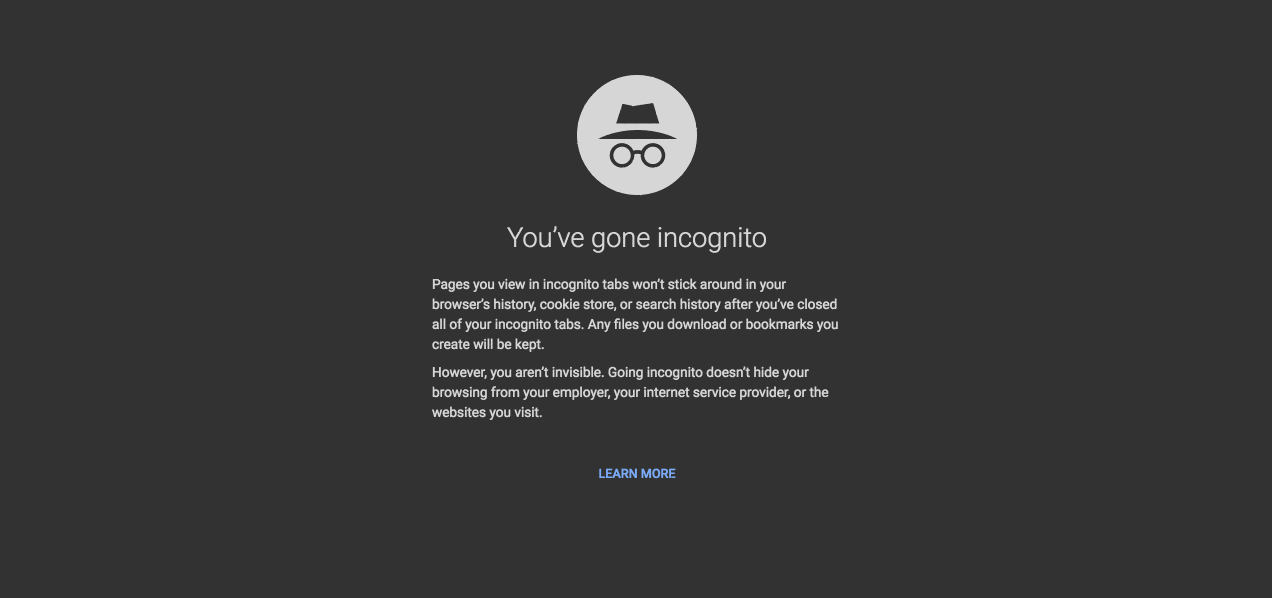
The pop-up just follows you around, over and over, to every page you visit. You can exit out as much as you want, but it seemingly doesn’t matter.
That’s how you lose visitors. For good.
Here’s what leads to that:
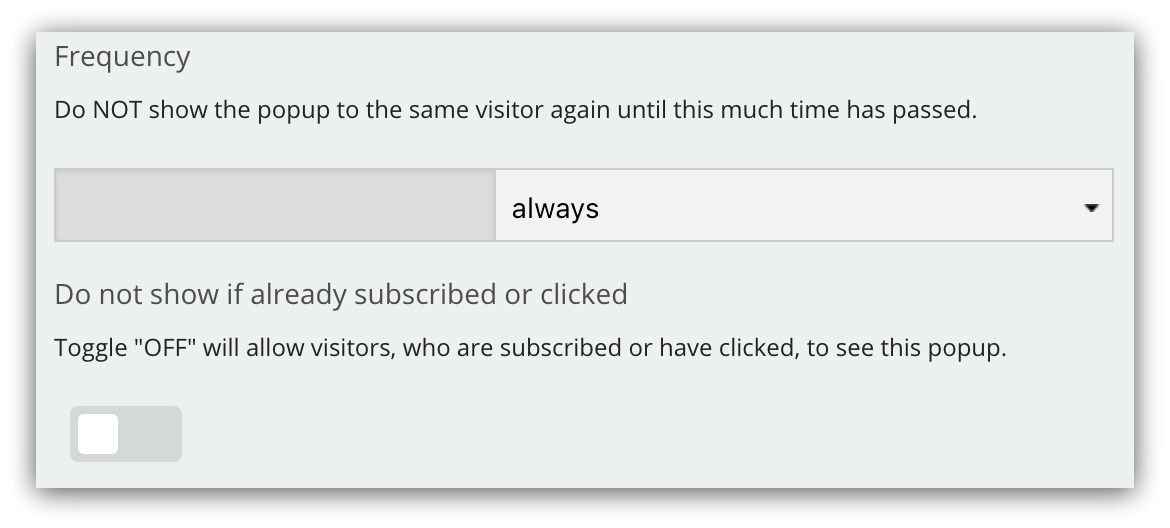
Frequency is how often you show your pop-up to the same visitor. You can go as small as hours or as long as years. Or you can always show a visitor you pop-up, no matter how often they say no.
Don’t do that.
You want to respect a visitor’s no. A good rule-of-thumb default that the best pop-ups follow is a one day minimum. If you’re a highly trafficked site, though, you can scale it back to 2+ days to ensure you don’t annoy visitors.
Subscribers means either allowing or not allowing people who have subscribed or clicked to see the pop-up. This should almost always be on so you don’t keep asking someone to perform an action they’ve already completed.
If a visitor tells you no by clearing your pop-up, you need to give time for that visitor to see the value of your site before you ask again. There’s a reason they’re saying no. Give them time and let your brand win them over.
7) Calls To Action Need To Match The Offer

The situation above is laughably weird and seems surreal.
But would you click “Purchase” when a pop-up offered a free trial?
Would you click “Subscribe” when a pop-up promised just an ebook?
And would you click “Join The Group” when a pop-up asks to sign up for a discount?
This disconnect would give you pause. If you were on a web page, you’d scan around to confirm you’re doing the right thing.
You don’t have that luxury with pop-ups.
People don’t feel obligated to pop-ups. You’ve got to remove any barriers, and that means linking up your call to action with your promise.
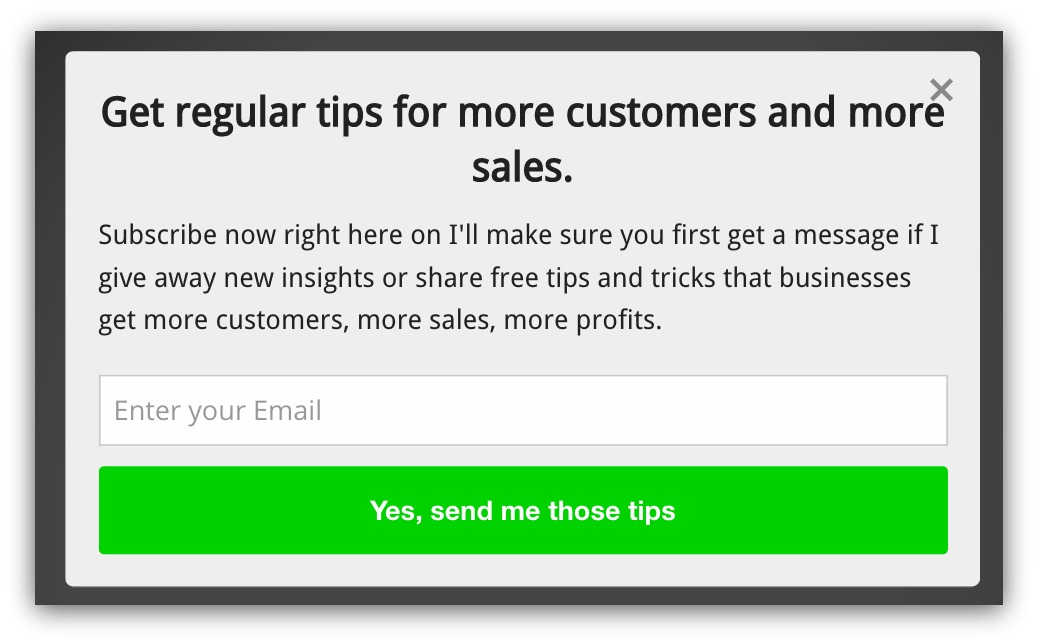
Here’s an easy enough example to follow. The headline promises regular tips. The description promises free tips and tricks.
So the call to action confirms that you’ll get those tips. That’s an approach that should be applied to all pop-ups.
If you’re asking someone to subscribe to a newsletter, say “Subscribe” or “Get Newsletter.” Being mindful of your promise and its relation to the CTA can save your pop-up from getting X’ed.
8) Exit Pop-ups Need An Overwhelmingly Valuable Offer
All the findings I’ve covered apply to how to set up a pop-up.
This finding is slightly different. Mostly because it’s a different type of pop-up altogether.
This applies to exit pop-ups, which appear when people are about to leave your site.
An exit pop-up is a phenomenal way to turn an otherwise negative thing (leaving your site) into a positive thing (subscribing, buying, etc).
This is a tricky pop-up, though. If visitors already don’t like pop-ups, then they really won’t want to see one as they’re leaving your site. Something made them leave, so that’s it! They’ve had it with your site.
But you can save that interaction. You just need to do some marketing judo and redirect their attention.
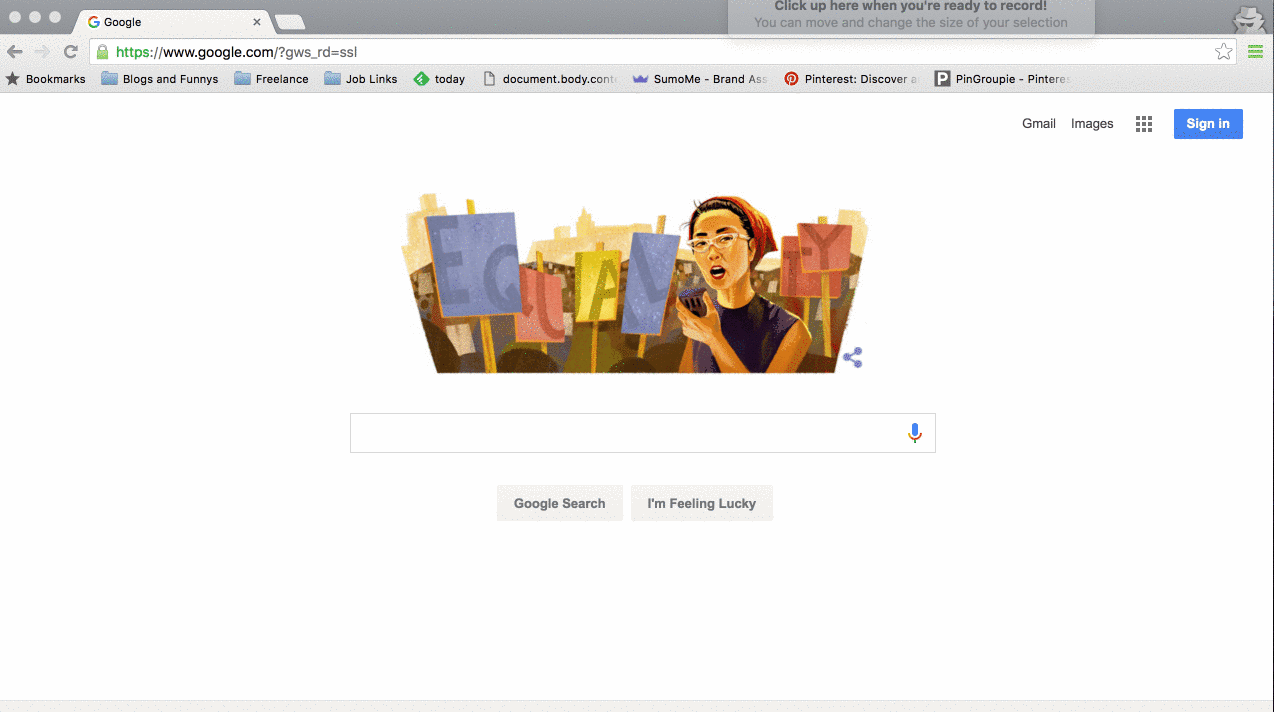
The pop-up appears as I’m about to leave. That’s the design element of attention. That’s not what you have to worry about.

You need to worry about your offer. It needs to be something that keeps the visitor’s attention. It should be your absolute best offer — the ace up your sleeve.
That exit pop-up in the GIF above is a perfect example. Peep promises to “Master the Essentials of Conversion Rate Optimization” and gives away a full ebook if you stay on the site.
That’s a strong giveaway that captures attention just like this pop-up:
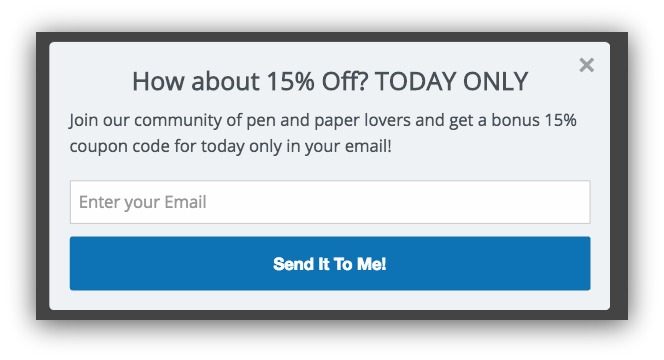
Maybe you thought you were going to leave the site without making a purchase? Nuh-uh. That 15% off code would entice even the stingiest of shoppers.
If you know what your offer is, and you follow all the tips in this guide, then setting up the actual exit pop-up is easy. You create everything like a normal pop-up, then do this:
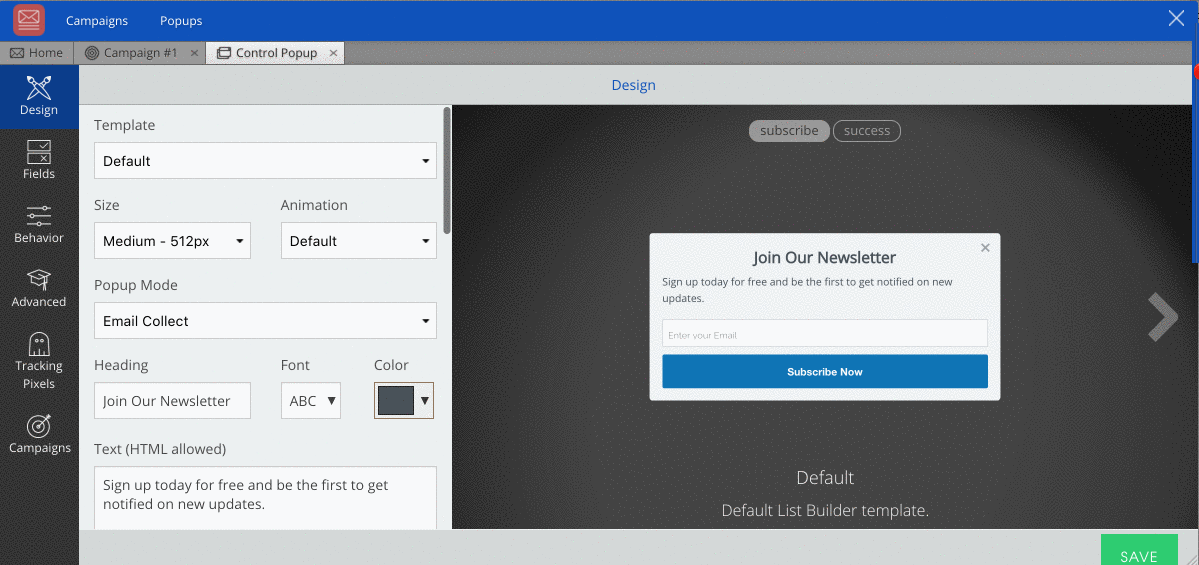
And that’s it.
We’ve seen a lot of excellent pop-ups in this guide. And that brings us to one last question.
What Does The Perfect Pop-up Look Like?
Alright. Maybe not perfect. Just because nothing is perfect (except for red Skittles).
So how about this. Here’s what an optimized pop-up should look like:
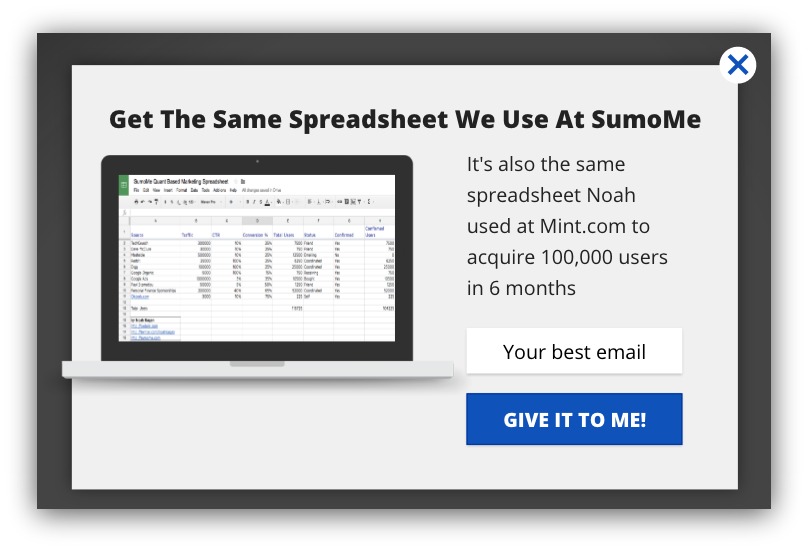
Yep, you saw this earlier in the article. So let’s break down why it’s so damn good:
-
It Has Context: This pop-up appears on our quant-based marketing guide. The spreadsheet directly relates to this guide.
-
There’s Enough Time: You don’t see this pop-up until you’ve already read a portion of the guide. It gives readers enough time to understand what quant-based marketing is.
-
It’s Clear and Direct: You know exactly what you get if you opt-in.
-
There’s Personality: A bit, but not a ton. The CTA button has personality, and we use a little of our own brand/social proof by mentioning Noah.
-
There’s Value: This spreadsheet is the exact same one Noah used to grow Mint.com.
-
CTA Matches Promise: You’ll get the spreadsheet if you opt-in.
All these factors lead into a tender 60% conversion rate.
Hey, we wouldn’t be publishing guides like this if we weren’t crushing it ourselves, right?
How To Create The Perfect Pop-ups
Ok, maybe not perfect but….you get the idea 🙂
There are subtleties that change with an exit pop-up, and it mostly comes in the form of the headline.
We made a Popup Headline Generator to help you write straightforward headlines for your popups.
Get The Popup Headline Generator
P.S. You might also enjoy this tutorial that shows EXACTLY how to setup Sumo’s three top performing pop-ups in under 30 minutes.
Add A Comment
VIEW THE COMMENTS